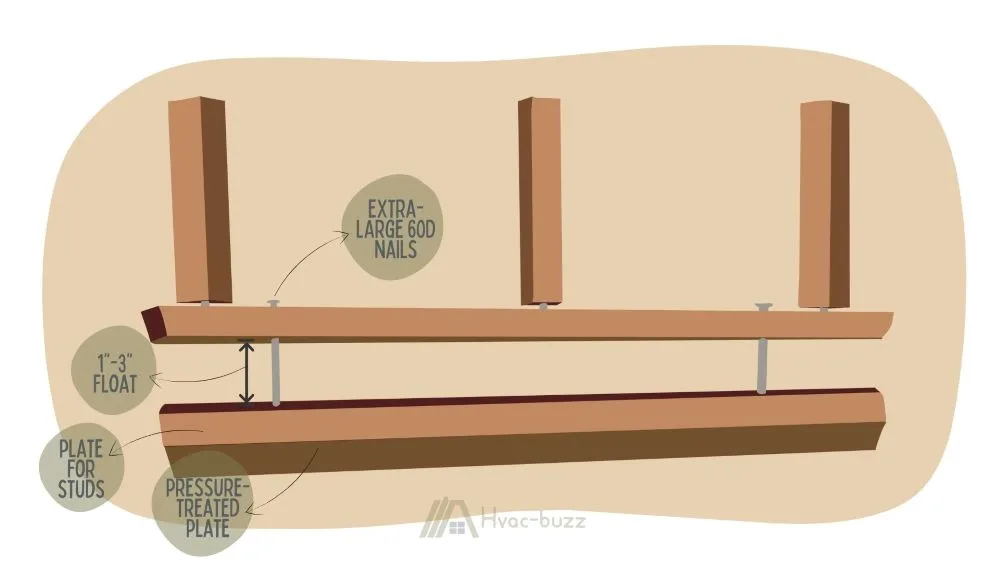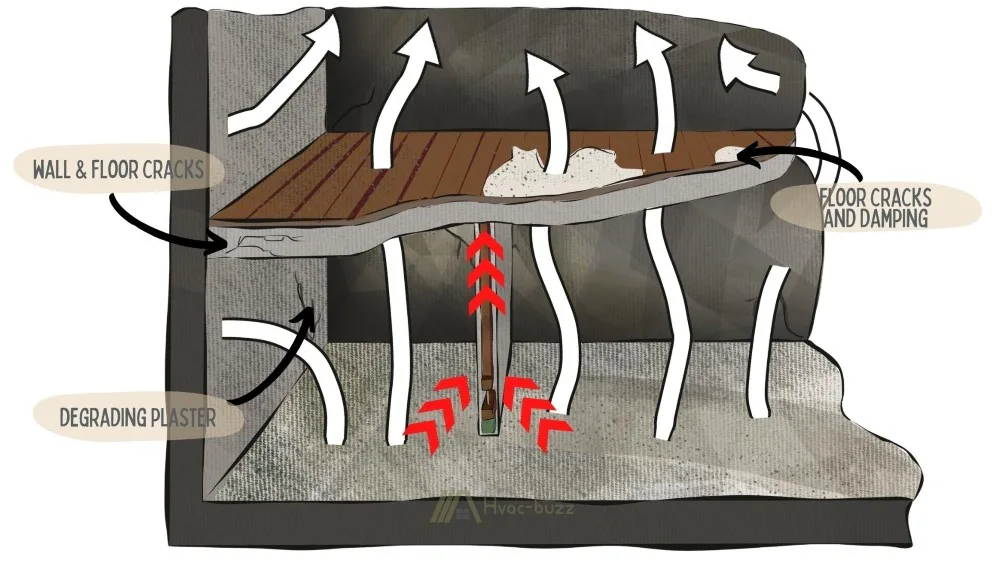Whether you have heard about floating walls before, or you have no clue what to imagine under this term, don’t worry. We’ve got you covered!
We’ll dig deep into the topic of floating walls and discuss what their purpose is, how do they work, and whether you need them or not. In the end, we will look at the necessary tools and helpful tips for installing a floating wall.

A floating wall is a non-load-bearing basement wall attached securely to the ceiling but attached to the bottom plate with long nails and a 1-3” gap between the wall and the bottom plate itself. The gap allows for the movement of a foundational slab in the presence of expansive soils.
Floating Wall Definition
A floating wall, as its name suggests, does not directly touch the ground. It is attached and hangs from the ceiling above it, creating a small gap between the wall and the floor.
Naturally, the wall is not just simply hanging in the air. It is also anchored to a floor plate with multiple long nails. This way of attachment allows for at least an inch gap between the wall and the floor plate.

What Is the Purpose of a Floating Wall?
Certain types of soils can quickly expand when they freeze or get wet. Due to the increase in volume, the soil starts pressing against the foundation of a house. This tends to shift the construction and slightly lift the floor, causing floor heaves.
The potential damage caused to the construction by the shifting of foundation varies greatly, ranging from superficial cracks in the drywall or destroying the floor above to ultimately compromising the structure of a house in some cases.
Even though the expansion of soil doesn’t always have to cause severe damage, it is still better to try minimizing it where possible.
Floating walls allow the soil to swell and the foundation to move without pressing against the walls and affecting the rest of the house.
This feature makes it a perfect type of wall for basements built in expansive soil (as is found in Colorado, for instance). Alternatively, it is great to be used with concrete flooring since concrete tends to shift slightly due to weather changes.
They enclose the area and provide you with an additional space where you can install shelves and racks. Typically, they are used as partition (curtain) walls in basements or garages.
Therefore, we could say that the primary purpose of floating walls is to protect the house’s structure and make it more stable, while still allowing your basement to be subdivided or finished.
How Does a Floating Wall Work?
Floating walls are attached to the ceiling and are anchored with 60D nails to a pressure-treated bottom plate on a floor. They are designed to protect the construction from ground expansion.
Floating walls are installed in a way that creates a gap between the wall and the floor plate. This allows the wall to slide up and down along the 60D nail, protecting the construction from floor heaves.
When the soil expands and moves the floor upward, the bottom plate will be lifted with the floor, but instead of pushing on the wall, it will only get closer to it, and the wall will stay in place and intact and the rest of the construction won’t be affected.
The needed size of a gap differs depending on your exact location, but it typically is at least 1″ to 1.5” and can climb up to 4”.

Can Floating Walls Be Load-Bearing?
Load-bearing or structural walls are always directly connected to the foundations. They transfer the house’s weight to the foundation in order to protect the integrity of the house.
A load-bearing wall supports the weight of the structure above it, whether it is a floor or a roof. A floating wall, on the other hand, is attached to the ceiling and entirely relies on it for support since it lacks any support of the floor. Therefore, it can, by definition, never be load-bearing.
If there any load were placed on them, the weight would be transferred to the pressure bottom plates, which are not designed to support such loads.
Where Are Floating Walls Necessary?
Floating walls are necessary for structures where a soil test has proved a presence of expansive elements in the soil.
These elements are clay minerals such as bentonite, smectite, montmorillonite, beidellite, etc. The soil’s expansive potential depends on the amount of the present clays.
Expansive soils can be found all around the world. In the US, they are prevalent in Colorado or Texas, Arizona, and Louisiana, but they are also very common in Canada, Australia, or the UK.
In some cases, the floating walls can be required by code. This is dependent on the number of expansive clays in your locality. Thus, there always needs to be a soil test performed prior to building.
Generally, it is a sound idea to use the floating walls as a frame around a masonry wall when finishing your basement or use them with a concrete floor.
Are There Ways to Recognize a Floating Wall?
Floating walls can have drywall on top and look nearly identical to a regular wall, recognizable only by professionals.
If you are in a location that makes you suspect that the walls in your basement are floated, there are some clues to look for when trying to decide whether you are right or not.
As we have already discussed, floating walls can’t be load-bearing, so you can rest assured that any structural wall is, in fact, not floated. Watch the video below on identifying a load-bearing wall.
Another telling sign is a baseboard. If there were none, you would obviously be able to see the drywall is not attached to the floor.
Baseboard used to cover floating walls are typically taller than the traditional ones, and it is nailed only to the nailing strip on the floor, not fixed to the wall itself.
Are Floating Walls Easy to Install?
Floating walls are not difficult to install if you have some building experience. The most critical part is to correctly measure and calculate how long the wall needs to be in order to leave the desired gap.
Here’s a table of steps and tools necessary to install a floating wall.
| Step | Tip | Tool (Amazon links) | Required Skill |
| Measure the space | Don’t forget to think about the thickness of your lumber to leave an appropriate gap at the bottom. |  | Measuring |
| Build the wall on the ground | Watch this video. |  | Measuring, drilling and cutting wood |
| Glue the treated bottom plate to the floor | First, use liquid nails to secure the bottom plate, and then add a few galvanized nails. |  | Aligning the bottom plate and |
| Attach the wall to the ceiling | Use clamp spacer to hold the wall up and screw it to the ceiling or use a nail gun. |  | Drilling, using screws or nail gun |
| Align the wall with the bottom plate | Use the square tool to make sure the wall is level. |  | Aligning |
| Anchor the bottom with 60D nails | First, drill holes into the plate and only then hammer the nails in. Otherwise, the plate could crack. |   | Drilling and hammering |
The best way to learn what to do is to see it. Check out these two videos if you are planning a floating wall DIY project.
Sources
https://staufferandsons.com/blog/what-are-floating-walls/
https://www.homequestionsanswered.com/what-is-a-floating-wall.htm
https://www.youtube.com/watch?v=aRC_cfVm_sc
https://www.sciencedirect.com/topics/engineering/expansive-soil
https://www.howtofinishmybasement.com/frame-basement-walls/#floatingwalls
https://finishedbasementsandmore.com/blog/floating-walls-used-colorado-basements/
https://geology.com/articles/expansive-soil.shtml
